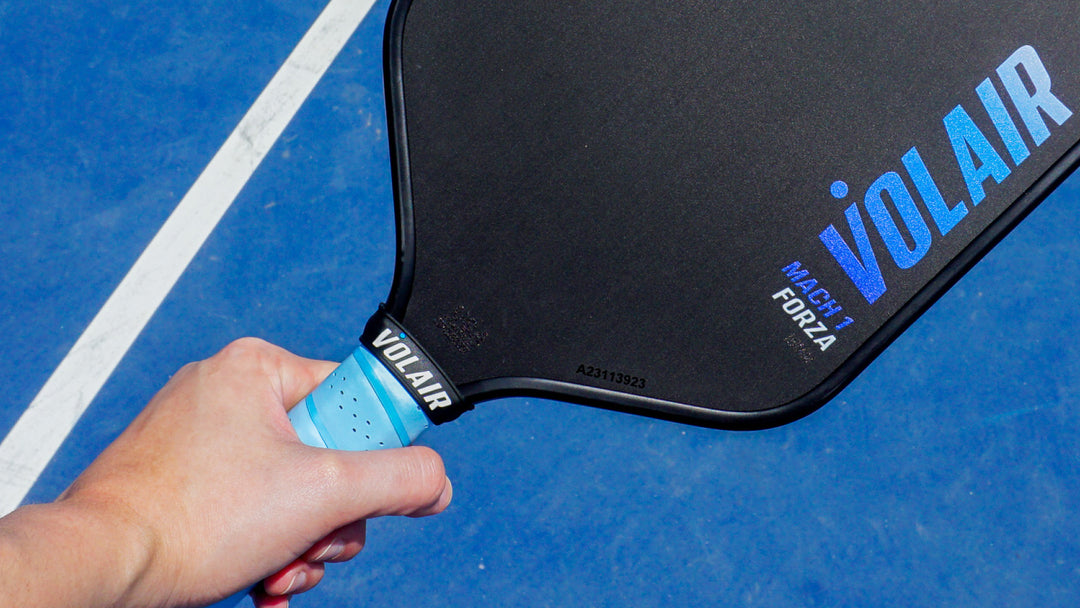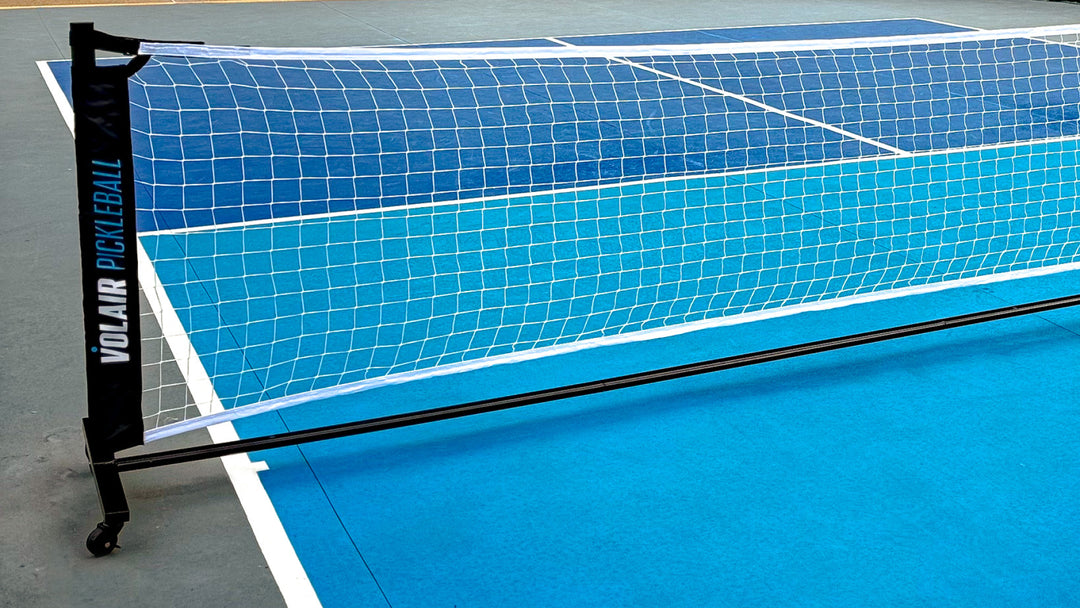Is Your Game Off? Don’t Check Your Paddle; Check Your Legs!
Ever miss a shot and you glare at your paddle like you could see a dead spot through the carbon fiber face? Unless you're wielding a specialized paddle designed for perfection, there's no obvious imperfection to blame.. So what went wrong?
Every pickleball shot is like a building, and like any building it requires a good foundation. You can build your house out of bricks, but it won’t stand on shaky ground. If you look up images of architecture, you’re unlikely to find pictures of well-laid basements; likewise, a search for pickleball shots won’t produce many close-ups of legs and feet. Yet, when my game is off, the most likely culprit is tired or injured legs. So let's get down into the basement of pickleball and build your game up from a solid foundation!
Introducing the “Three Threes” of pickleball footwork:
The Three Goals of Good Footwork
Why is good footwork so important? Well, there are three major benefits:
-
Balance
- Luck might win points, but consistency wins games! And balance is the key to consistency. Just like twist weight can keep a paddle from turning in your hand, good balance can keep you from falling over -- sort of like the twist weight of your whole body. And just like twist weight leads to better control, balance makes the dynamics of your motion more stable and predictable, keeping your shots on target.
- You might think of balance as something static, but it determines how quickly you’re able to spring into action and react to your opponent’s shot. If you’ve ever been caught out by a lob, chances are you were leaning forward near the kitchen line. Your opponent spotted that and sent the ball high and long. If you lean too far left or right, all your opponent has to do is hit it in the other direction.
-
Positioning
There are two kinds of positioning, macro and micro, and both are vital!
- Macro positioning refers to where you’re standing on the court. Getting caught out of place is an easy way to lose a point. We’ll discuss the three distinct zones later, but good footwork is not only necessary for getting to the right place, it’s essential for getting there with minimal risk and exposure. In doubles, you also need to adjust to your partner’s position as they move.
- Micro positioning is in relation to the ball. The goal here is to contact the ball in front of your body. This can require a lot of small steps and adjustments to make sure you are hitting the ball in the exact right place and right time. These tiny adjustments are particularly important for drives, ensuring the weight of your body is moving forward at the end of every shot.
-
Injury Prevention
- Even the most experienced athletes get hurt from time to time. More often than not, it comes from accidental, improper movement. While they might be moving faster than an amateur, meaning a small misstep can exert greater forces on their joints and ligaments, they are well-trained.
- Enthusiasts like us are much more likely to take a wrong step. In the last half year, I’ve seen ACL injuries, broken wrists, torn ankles, and even concussions happen on the court. I myself suffered a sacroiliac injury due to an abrupt stop as a result of improper footwork. Improving our technique can help prevent injuries and keep us pickling happily.

Three Fundamentals of Pickleball Footwork
While mastering footwork is a lifelong pursuit full of nuance, implementing the following three techniques will go a long way towards improving your game and keeping your legs healthy.
-
Split Step
- The split step is a simple move: widen your legs to shoulder-width or a bit wider, crouch down slightly to lower your center of gravity, and put equal weight on each foot. This is typically a transitional stance which may only be held for a fraction of a second.
- The purpose of a split step is to achieve a moment of balance and stability in anticipation of an opponent’s shot. This brief stance gets you ready to reposition in any direction, so you can react to whatever comes your way with small or large adjustments.
- The best moment to execute a split step is right as your opponent is striking the ball. This is particularly important if you’re charging forward from the baseline to the kitchen.
-
Shuffle
- The shuffle step is key for lateral movement, and doing it is easy. Push off with your trailing leg -- the one opposite of the direction you’re moving in -- while you reach out with your lead leg, then bring your trailing leg back beneath you to a neutral, balanced position. The movement is quick and can be repeated multiple times, taking bigger or smaller steps as needed. Your legs should never cross or make contact with one another while shuffling.
- This technique lets you retain maximum balance while moving, keeping your core stable, with your shoulders pointed forward towards your opponents. Even with exaggerated shuffles like you might see in a football workout, the arms move little when compared to a run. This keeps your paddle steady and ready as you move.
- Responding to dinks with shuffling rather than lunging keeps your balance up higher and puts you in a better position to respond to a sudden speed up, which is harder when coming out of a deep lunge.
- The downside of a shuffle is that it can be harder on the joints, trip you up, and leave you out of place. So if you shuffle out wide to reach a dink, don’t forget to shuffle back into place before your opponents can exploit the gap!
-
Lunge
- Regardless of how much you shuffle, you may have to reach for a low ball. For this, you’ll need to squat or lunge. Lunging keeps your movement efficient. If executed properly, it allows you to reach balls in a balanced, stable position.
- A lunge places most of your weight on the lead leg, so you’ll need to return to a neutral position as soon as possible in order to react to the next shot. Bear in mind that the deeper the lunge, the harder it is to come out of it, so you’ll want to pair lunges with shuffles to keep them shallow and fast.
- Even at the baseline, lunges are a great final action when chasing a ball with a wide angle. If you watch pickleball or tennis pros, you’ll notice that they tend to strike a pose right as they contact the ball. This too is a form of a lunge. In other words, lunges can be fast and subtle, not just slow, exaggerated motions you do with your hands on your hips while sweating to the oldies at the gym in your favorite leotard.

All of this adds up to a killer glute and leg workout. I used to do kickboxing, lift weights, and play soccer, and my legs have never been in better shape than while consistently playing pickleball!
The Three Zones
Knowing when and where to be on the court is beyond the scope of this article; However, it is important to note how your balance and movement differ in the three sections of the court.

-
Baseline
- The baseline is the back section of the court and beyond it. You serve here, return serves here, and are sometimes forced to retreat here.
- Although your goal is to race back to the kitchen whenever you get the chance, there’s a couple of great advantages to standing just behind the baseline. First, every ball has to bounce in front of you, or it’s out. Because of this, motion here is mostly 1.5D -- left, right, and forward. Second, you have more time to react to shots as the ball has further to travel.
- However, the movement required here is usually bigger and more tennis-like. You may need to reach several feet beyond the lateral edge of the court to return an opponent’s shot, or race forward to the kitchen to deal with a soft drop. In other words, being ready to move quickly at the baseline is key.
-
Transition Zone
- The space between the baseline and the kitchen is known as the transition zone. It’s also sometimes called “no-man’s land” because it’s the most challenging place on the court since the ball can be hit in front, behind, or right at you. In other words, movement is fully 2D, and you have to be ready for anything.
- Though you’ll want to get out of the transition zone and to the kitchen line as fast as possible, while you’re here, it’s split step central! Perhaps the most crucial bit of footwork in all of pickleball is hitting a solid split step at the right time in the transition zone and not just continuing to rush forward as your opponent strikes the ball, as hitting a return to a player in motion is always a good strategy.
-
Kitchen Line
- The kitchen line separates the NVZ (non-volley zone) from the rest of the court. It’s as close as you can stand to your opponent before they return the ball. Movement here is mostly 1D, left and right, sometimes reaching or stepping forward into the kitchen proper. But don’t be afraid to take a step back when the occasion calls for it!
- The kitchen line is where the shuffle really shines. You’ll want to quickly shift left and right in response to the ball's movement. In doubles, you and your partner should move together as if you were bound together by an imaginary rope. This is true everywhere on the court, but it’s most pronounced here.
- Balance is a bit different in the kitchen. You’ll notice that most pros get lower and lean forward to take balls out of the air and surprise their opponents, but it’s critical to not overextend yourself, and that might require patience… and lunges! Whether you lunge or shuffle, don’t forget to reset your position!
Make it Natural
Despite that most of your movement takes place in a 10’ by 15’ rectangle, it all adds up. In preparation for this article, I tracked my movement using a smartwatch, and I found that I average 4.8 miles in around 2 hours of casual play, with typical games ranging between .4 and .6 miles. Pickleball is one of the only sports where a 42 year old like me can be praised for “young legs.” Gotta love it!

Not all of this movement can be shuffles, lunges, and split steps. These three techniques are solid ground on which to lay your foundation, but once your footwork improves, it doesn’t have to be rigid. While the pros’ footwork is more uniform than amateurs, it’s not mechanical. In order to be creative and dynamic safely and effectively, it’s essential to first master the fundamentals. In the end, the goal of footwork is to consistently maintain balance, get to where you need to be, keep the ball in front of you, and stay safe!
So next time you miss a shot, spare the paddle, glare at your feet.
Conclusion
In conclusion, the game of pickleball is not merely about the paddle in your hand, but also about the foundation beneath you – your legs and feet. Despite the allure of blaming equipment for missed shots, the reality often lies in the realm of footwork. Just as a well-constructed building requires a solid foundation, successful pickleball play necessitates a sturdy base of footwork fundamentals.
By focusing on the "Three Threes" – the Three Goals of Good Footwork, the Three Fundamentals of Pickleball Footwork, and the Three Zones of the Court – players can enhance their balance, positioning, and injury prevention while mastering essential techniques like the split step, shuffle, and lunge. Through dedicated practice and attention to detail, players can transform their footwork from a mechanical necessity to a fluid, instinctive aspect of their game.
So, the next time you find your game faltering, resist the urge to blame the paddle and instead, turn your attention to your feet. By honing your footwork skills, you'll not only improve your performance on the court but also lay a solid foundation for long-term success in the sport of pickleball. After all, in pickleball as in life, it's often the groundwork that makes all the difference.




